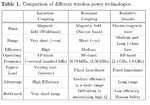nataddrho
Newbie level 4
Greetings.
I've designed and manufactured about 20 units of a small wireless charger for a product I am working on as a side project from my day job. The charger is very simple: 5VDC from USB-C source, boost converter to 12VDC, and then a low power H-Bridge (UCC37321 / UCC37322 opposite each other) driving a Wurth charge coil and an appropriate capacitance in series to resonate at 6.78 MHz. I use a precision clock for the frequency source. It works fine and the capacitor voltage approaches 50V. The receiving device has a 6.78 MHz tank (capacitor in parallel with smaller coil) attached to an energy harvester, which has an efficient recitifier and boost electronics for charging an LiPO.
The wireless charger draws about 0.1A, and I receive ~3mA at a range of about 1/4" on average, which a about 1.5 coil widths distance for the receiving device. The Q is about 1300 theoreticaly, but there is a little more bandwidth experimentally. If I use NP0 low tolerance parts then I should be within something acceptable without needing to auto tune. There is a lot of room for optimizing but good enough to showcase the functionality of the product to a company.
The question I have is:
I have not yet gone through the process for FCC testing for "intentional" radiating devices. I've only done "un-intentional". I chose 6.78 MHz because I don't yet have a good artistic feel for how much power is acceptable. It may be that the wireless charger will never ciolate standards at any frequency, and I would get better efficiency at lower frequencies that I think are forbidden.
For ISM, I tried to figure out what the radiated energy is, but this is the first time doing this. Can you check my calculations? I am assuming the transmitting coil has 0.4ARMS. The transmit and receive coil both have ferrite pads on opposite sides to help with flux concentration, but that is not included in the calculation. (SEE ATTACHED PDF)
Nate
I've designed and manufactured about 20 units of a small wireless charger for a product I am working on as a side project from my day job. The charger is very simple: 5VDC from USB-C source, boost converter to 12VDC, and then a low power H-Bridge (UCC37321 / UCC37322 opposite each other) driving a Wurth charge coil and an appropriate capacitance in series to resonate at 6.78 MHz. I use a precision clock for the frequency source. It works fine and the capacitor voltage approaches 50V. The receiving device has a 6.78 MHz tank (capacitor in parallel with smaller coil) attached to an energy harvester, which has an efficient recitifier and boost electronics for charging an LiPO.
The wireless charger draws about 0.1A, and I receive ~3mA at a range of about 1/4" on average, which a about 1.5 coil widths distance for the receiving device. The Q is about 1300 theoreticaly, but there is a little more bandwidth experimentally. If I use NP0 low tolerance parts then I should be within something acceptable without needing to auto tune. There is a lot of room for optimizing but good enough to showcase the functionality of the product to a company.
The question I have is:
I have not yet gone through the process for FCC testing for "intentional" radiating devices. I've only done "un-intentional". I chose 6.78 MHz because I don't yet have a good artistic feel for how much power is acceptable. It may be that the wireless charger will never ciolate standards at any frequency, and I would get better efficiency at lower frequencies that I think are forbidden.
For ISM, I tried to figure out what the radiated energy is, but this is the first time doing this. Can you check my calculations? I am assuming the transmitting coil has 0.4ARMS. The transmit and receive coil both have ferrite pads on opposite sides to help with flux concentration, but that is not included in the calculation. (SEE ATTACHED PDF)
Nate
